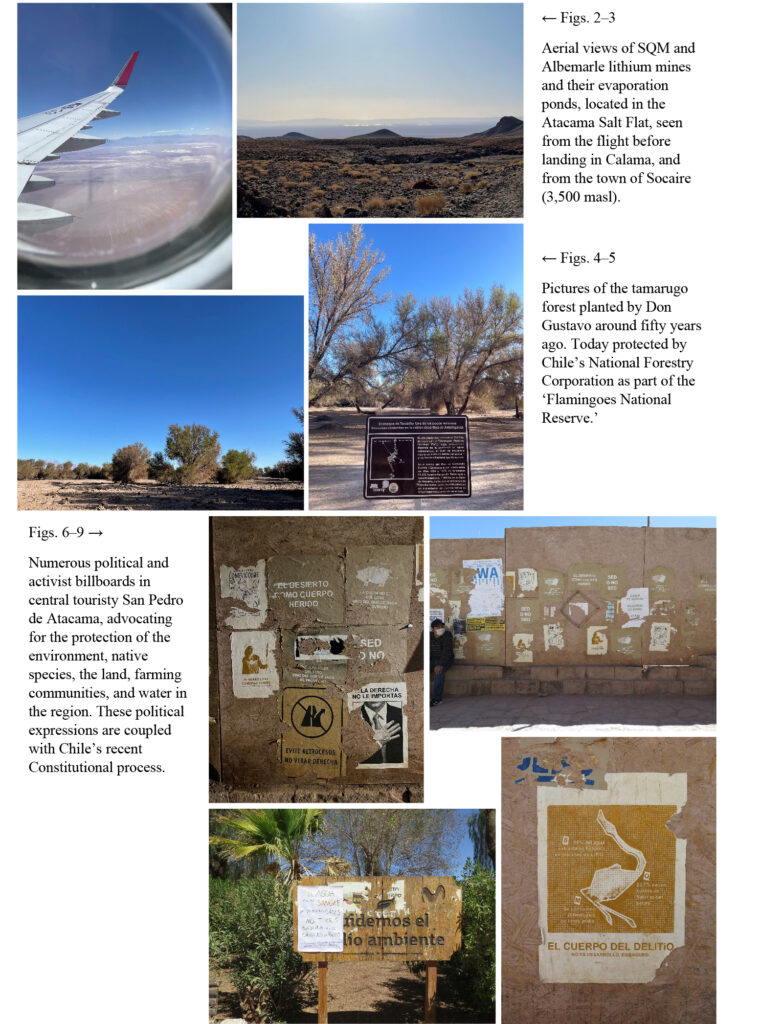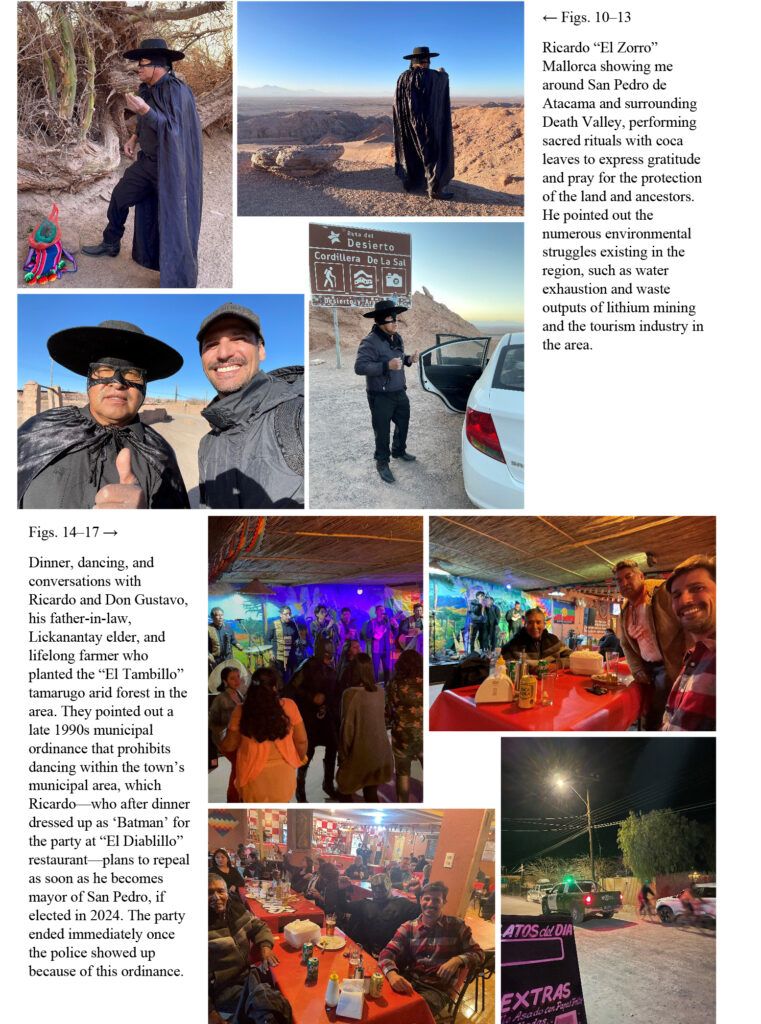Hernán L. Bianchi Benguria 2021 Field Report
Demystifying Electromobility: The Lithium Hinterland and Socioenvironmental Justice in the Atacama Desert
Research Topic Outline
The Kyoto process and the work of the Inter-governmental Panel on Climate Change (IPCC) have placed climate change as humanity’s most pressing challenge, with renewable energy seen by many as a key foundation of post-fossil energy, integral to low-carbon futures, and a possible “renaissance” for future development (Nadaï & Van Der Host 2010, 144). The IPCC features electromobility as one of the key mitigation options for a “rapid, systemic” transition to cap global warming at 1.5ºC, as outlined in the 2016 Paris Agreement (Masson-Delmotte et al. 2018, 41). For road transport, “hybrid electric vehicles are … instrumental to enabling the transition from internal combustion engine vehicles to electric vehicles” (pp. 142–143), a transition which is underway.[1] In short, electromobility is positioned in the policy mainstream as one of the main climate transition strategies for the world’s transport infrastructure.
Yet replacing the world’s cars with electric vehicles (EVs) requires lithium-ion batteries that make them go. Deploying energy storage technology has become a global and globe-spanning project, requiring investments to extract unprecedented amounts of minerals—including lithium, cobalt, copper, graphite, and nickel—to manufacture batteries, as well as their respective charge/discharge components and infrastructure.[2] Some of these energy transition minerals are extracted from places such as the Atacama Desert in Northern Chile—the most arid biome in the world. The Atacama Salt Flat is considered part of what has been infamously referred to as the “lithium triangle,” including the Andean High Plateau across Argentina, Bolivia, and Chile—a region reportedly holding over half of the world’s commercially feasible lithium reserves (USGS 2022). The Atacama Salt Flat contains Chile’s only two operational lithium mines, where lithium and other minerals are extracted from underground brine deposits.[3] However, a growing number of mining ventures have shown interest in expanded extraction in this area and other salt flats with lithium deposits across the Atacama Desert, fueled by the electro-mobility transition (Blair et al. 2022; GAC 2017; Jerez Henríquez 2018).
CLAG Field Study Report 3
My research focuses on interrogating the electromobility transition—marketed as a technological fix in the global move towards decarbonization—by examining how green development and capitalist imperatives exists in relation to the contestation of the Atacama Desert, and the ways in which this tension is negotiated, contained, and resolved. My work thus aims to help define under which conditions lithium extraction can proceed or be resisted, and what kind of development policies, practices, and socioecological relations do in fact interrogate and contest extractivist development models more broadly.[4]
By exploring connections between territorial logics of capitalist expansion, sovereignty, and Indigenous claims, my research focuses on electromobility as an environmental fix (Ekers & Prudham 2015; Goldstein 2018; Sheller 2014; Smith 2008). I thus intend to use critiques of sustainable development and technological fetishism (Feenberg 1991; Harvey 2003; Hornborg 2014) to investigate how colonial forms of exploitation and capitalist expansion are embedded in development policy. As electromobility is promoted across the world to address the titanic challenge of climate change, the outcomes of extraction are shifting and emerging in specific places—such as with lithium mining. Such impacts tend to be obscured not by sustainable development policies only, but also specifically by the idealization of electromobility as a socio-technical and environmental fix.The struggle and response of the Lickanantay to both existing and new extraction ventures in the Atacama Salt Flat area—in the face of the electromobility transition—speaks of a series of socioenvironmental issues being overlooked by the ‘sustainable development’ status quo. Investigating and carefully listening to the Lickanantay’s struggle and acts of resistance will help me understand the interplay between the politics of lithium and environmental justice. Furthermore, by contrasting the politics of clean energy with what is happening on the ground, will show evidence of how a process of dispossession through green capitalism is articulated and materialized. Ultimately, my long-term goal is to contribute to what we need to know—as citizens, activists, scholars, professionals, and/or decisionmakers—in mobilizing a praxis aimed at socio-environmental justice in the face of extraction. Indeed, the knowledge probed throughout this work is intended to provide further clarity when contesting resource, energy, and even mobility enclosures, as to envision, mobilize, and democratize the commons and new ways of commoning (De Angelis 2004; Federici 2004; Li 2014; Linebaugh 2014; Marx 2015).
Field trip Method
There are two main sites of analysis located in Canada and Chile, far apart from each other on opposite sides of the American continent. In the case of Canada, the University of Toronto St. George campus will host most of the desk research, remote interviews, data analysis, and fieldwork preparations. In Chile, the small town of San Pedro de Atacama (urban population 5,717 [INE 2017]) will serve as basecamp for most of the fieldwork; including in-person interviews and participant observation in the nearby Atacama Salt Flat lithium mines, and surrounding Lickanantay Indigenous communities.
Preliminary Results
During fieldwork I was able to observe and record some of the new dynamics taking place in the area with the lithium boom. I conducted a series of informal interviews, site observations, and contacts. This was done through photographic and filmed registry, as well as through recorded conversations with Indigenous activists, laborers, and mining industry professionals.
Among these actors, I contacted a Lickanantay activist named Ricardo Mallorca, who will run for mayor of San Pedro next year. Nicknamed “El Zorro,” he promotes the community’s environmental struggles by dressing up as different superheroes. Zorro showed me around the area, performed sacred rituals with me to respect the land and ancestors, and introduced me to his father-in-law Don Gustavo, an Indigenous elder that still farms the land in the desert, and who half a century ago planted one of the only arid forests with native species existing in the region.

Fig. 1: Map of trinational region showing major Andean and Pre-Andean salt flats.
Endnotes
[1] “Sales of electric vehicles (EVs) doubled in 2021 from the previous year to a new record of 6.6 million. Back in 2012, just 120,000 electric cars were sold worldwide. In 2021, more than that many are sold each week. Nearly 10% of global car sales were electric in 2021, four times the market share in 2019. This brought the total number of electric cars on the world’s roads to about 16.5 million, triple the amount in 2018 … Under current policy plans
EVs reach just over 20% of sales in 2030, increasing the stock 11-fold … to 200 million vehicles.” (IEA 2022, 4–5).
[2] An EV’s powertrain on average requires “twice as much copper as internal combustion engines” (Scheyder 2019); “a concerted effort to reach the goals of the Paris Agreement … would mean a quadrupling of mineral requirements for clean energy technologies by 2040 … In climate-driven scenarios, mineral demand for use in EVs and battery storage [will grow] at least thirty times to 2040. Lithium sees the fastest growth, with demand growing by over 40 times … by 2040, followed by graphite, cobalt, and nickel (around 20-25 times) … expansion of electricity networks means that copper demand for power lines more than doubles over the same period” (IEA 2021, 8).
[3] Combined with potassium salts extracted from the Atacama Salt Flat. Considering the evaporation ponds used to extract lithium in the Atacama Desert—which is particularly intense in terms of water consumption compared to other mining methods—roughly 2 million liters of water are used for each ton of lithium production; viz. 2,200 liters of water are evaporated to obtain one kilogram of lithium (Blair et al. 2022, 11). A single higher-end performance EV—such as the Tesla model S—requires twelve kilograms of lithium for its batteries (Katwala 2018).
[4] “In the narrow sense, extraction and extractivism are usually understood in reference to mass-scale industrial extraction of non-renewable natural resources, most particularly the extraction of oil, gas and minerals, and to the ideologies, discourses and practices underpinning these industries’ standing within the society. However, more recently extractivism—and alternatively, ‘neo-extractivism’ or ‘new extractivism’—is increasingly viewed in a much broader sense, as an ideological construct and a paradigm of severe exploitation which is characteristic of contemporary capitalism and neoliberalism at large. In this expanded sense, extraction and extractivism are no longer necessarily defined by certain types of industries and activities, or tied to questions of land and natural resources as given objects that are disconnected from others. Instead, ‘extractivism’ is increasingly understood also as an analytical and also political concept that enables the examination and articulation of deeper underlying logics of exploitation and subjectification that are central to the present conjuncture of capitalist globalization and neoliberalism” (Junka-Aikio & Cortes-Severino 2017, 177).
References
Barandiarán, J. (2019). Lithium and development imaginaries in Chile, Argentina, and Bolivia. World Development, 113, 381–391.
Blair, J.A., Balcázar, R.M., Barandiarán, J., & Maxwell, A. (2022, April). Agotado: Cómo evitar que la minería del litio agote el recurso hídrico, drene los humedales y perjudique a las comunidades en América del Sur. NRDC. https://www.nrdc.org/sites/default/files/exhausted-lithium-mining-south-america-report-spanish.pdf
De Angelis, M. (2004). Separating the doing and the deed: Capital and the continuous character of enclosures. Historical Materialism, 12(2), 57–87.
Ekers, M. & Prudham, S. (2015). Editorial introduction: Towards the socio-ecological fix. Environment and Planning A, 47, 2,438–2,445.
Federici, S. (2004). Caliban and the witch: Women, the body, and primitive accumulation. Brooklyn, NY: Autonomedia.
Feenberg, A. (1991). Critical theory of technology. New York, NY: Oxford University Press.
GAC [Gestión Ambiental Consultores – Ecology and Environment, Inc.]. (2017, December). Estudio para el análisis y preparación de un plan de trabajo en relación a las distintas RCA sobre el Salar de Atacama. Corfo – Comité de Minería No Metálica.
Goldstein, J. (2018). Planetary improvement: Cleantech entrepreneurship and the contradictions of green capitalism. Cambridge, MA: MIT Press.
Harvey, D. (2003). The fetish of technology: Causes and consequences. Macalester International, 13(7), 3–30.
IEA [International Energy Agency]. (2022). Global EV outlook 2022: Securing supplies for an electric future. https://www.iea.org/reports/global-ev-outlook-2022
IEA (2021). The role of critical minerals in clean energy transitions. https://www.iea.org/reports/the-role-of-critical-minerals-in-clean-energy-transitions
INE [Instituto Nacional de Estadísticas]. (2017). Resultados Censo 2017: Por país, regiones y comunas. http://resultados.censo2017.cl/
Junka-Aikio, L. & Cortes-Severino, C. (2017). Cultural studies of extraction. Cultural Studies, 31(2–3), 175–184.
Katwala, A. (2018, August 5). The spiralling environmental cost of our lithium battery addiction. Wired. https://www.wired.co.uk/article/lithium-batteries-environment-impact
Li, T.M. (2014). Land’s end: Capitalist relations on an Indigenous frontier. Durham, NC: Duke University Press.
Linebaugh, P. (2014). Stop, thief! The commons, enclosures, and resistance. Oakland, CA: PM Press.
Marx, K. (2015 [1867]). Capital: A critique of political economy (F. Engels, Ed.) (Vol. 1) (S. Moore & E. Aveling, Trans.) (Rev. ed.). Moscow: Progress Publishers. Retrieved from https://www.marxists.org/archive/marx/works/download/pdf/Capital-Volume-I.pdf
Masson-Delmotte, V., Zhai, P., Pörtner, H.-O., Roberts, D., Skea, J., Shukla, P.R., Pirani, A., Moufouma-Okia, W., Péan, C., Pidcock, R., Connors, S., Matthews, J.B.R., Chen, Y., Zhou, X., Gomis, M.I., Lonnoy, E., Maycock, T., Tignor, M., & Waterfield, T. (2018). Global Warming of 1.5°C: An IPCC Special Report on the impacts of global warming of 1.5°C above pre-industrial levels and related global greenhouse gas emission pathways, in the context of strengthening the global response to the threat of climate change, sustainable development, and efforts to eradicate poverty. IPCC [Intergovernmental Panel on Climate Change]. https://www.ipcc.ch/sr15/download/#full
Nadaï, A. & Van Der Host, D. (2010). Introduction: Landscapes of Energies. Landscape Research, 35(2), 143–155.
Prieto, M. (2016). Practicing costumbres and the decommodification of nature: The Chilean water markets and the Atacameño people. Geoforum, 77, 28–39.
Sheller, M. (2014). Introduction: Mobilizing Modernity & Conclusion: Slow Metal. In Aluminum dreams: The making of light modernity (pp. 1–31, 247–263). Cambridge, MA: The MIT Press.
Smith, N. (2008 [1984]). Uneven development: Nature, capital, and the production of space (3rd ed.). Athens, GA: University of Georgia Press.
USGS. (2022). Mineral Commodity Summaries 2022. Washington DC: U.S. Department of the Interior. https://doi.org/10.3133/mcs2022


For more details please see the full report.


















